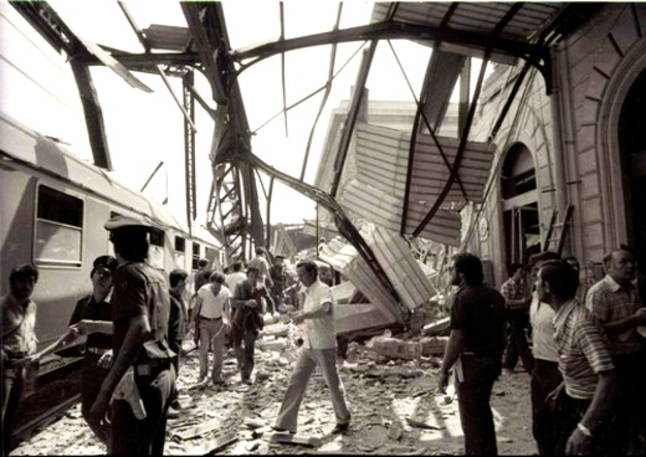


Bologna, August 2, 2010, 10.25 a.m.
A ghostly silence is broken by a list of names read aloud in a railway station. Thirty years have passed since August 2, 1980 when a bomb exploded at the Central Railway Station killing 85 people and wounding more than 200. The victims were mainly station workers, passengers, tourists, some from foreign nations, and other visitors. The attack has been attributed to the NAR (Nuclei Armati Rivoluzionari), a neo-fascist terrorist organization. The bomb, contained in an unattended suitcase inside an air-conditioned waiting room, exploded at 10.25 a.m. The choice of the day, the first Saturday of August, the hour, and the location clearly indicate that the bombing had been planned in order to target as many victims as possible during the period when hundreds are usually setting off on their holidays. And, in fact, it remains the most devastating terrorist attack in Italian history and is considered to be the culmination of a decade of terrorist violence by right and left extremist groups.
During the 1970s and 1980s in Italy there was the so-called “strategy of tension,” that is, a series of terrorist attacks launched around the same time with no clear central catalyst or focus such as a failed military plot or Masonic groups trying (and in many cases, succeeding) to gain power by installing their members within national institutions. Details about most of these events are still shrouded in “state secret” and surrounded by an aura of mystery. The explosion in Bologna nearly destroyed the main building and hit the Ancona-Chiasso train that was waiting for the signal to leave from the first platform.
The station was full of tourists and the city was not prepared to face such a massively tragic event. There were not enough ambulances so it was necessary to use taxis and buses to transport the wounded to various hospitals in the area. The reason why terrorists chose Bologna, according to those who investigated the bombing, could be found in its history of left-wing politics along with its strong civic culture and anti-fascism and Partisan tradition. The tragic event immediately inspired Bologna’s residents to react against the terrorist act: a few hours later many citizens had spontaneously gathered to show that the city was alive despite the death toll that rose with each passing hour. Since then, there have been annual events commemorating the tragedy on behalf of the families of the victims. Inside the station the original clock has remained permanently set at 10.25 a.m., and inside the rebuilt waiting room there are still edges of the wall that was blown apart by the bomb. On the floor the crater has been preserved in order to show the exact spot where the bomb exploded. Every year the commemoration ceremony begins with a march through the city with many of the victims’ families taking part. And, over the years, cultural and artistic events have become a part of the tribute, an increasingly creative way to express the city’s own collective memory.
Outside the Central Station and in Bologna’s main square, Piazza Maggiore, memorials honoring the victims were placed next to portraits of Partisans who died during the Italian Resistance against the Nazi occupation during the Second World War. It is a way to share pages from the nation’s history with new generations who must not forget the horror. A long and controversial court case began after the bombing, and thirty years later it is still full of murky issues despite sentencing the two terrorists to life imprisonment.
Francesca Mambro and Giusva Fioravanti who belong to NAR’s extreme-right group keep proclaiming their innocence in the bombing while admitting their involvement in 33 murders during the so-called “Anni di Piombo.” Of course, relatives of the victims, united in an association, do not believe their innocence and want to know the names of all those involved in the massacre beginning with those who planned it to those who personally planted the bomb. Among the many hypotheses, one theory purports that officials in the Italian Secret Service were involved along with members of the secret organization known as the P2. After thirty years there are still so many questions but very few certain facts.
This year the memorial for the thirtieth anniversary was surrounded by controversy that, as long as Silvio Berlusconi is prime minister, never fails to emerge. The government, in fact, decided for the first time not to send ministers and other officials to attend to the ceremonies. The reason for this is that every year the representatives of the government have been targeted by protesters in the crowd and by families of the victims who will persist until they learn the truth about how and why their loved ones dies. This decision was viewed by the public and political opponents to the center-right government as a way to escape from an “unpleasant” situation while dodging critics and detractors. Paolo Bolognesi, president of the victims’ association said: “Ours has been a long battle against the passing of time, against the silence and the lies, against those who want us to forget.” Mr. Bolognesi called for the government to open all files on the case and to uncover all of the secrets that are behind the bombing.
One more year has passed and so many questions are still waiting for a definitive answer, while the commemoration ceremonies demonstrated that despite the never-ending pain of striking the “rubber wall,” it remains impenetrable.
Source URL: http://test.iitaly.org/magazine/focus/facts-stories/article/massacre-bologna-30-years-later
Links
[1] http://test.iitaly.org/files/stragebolognacopertina1280866645jpeg